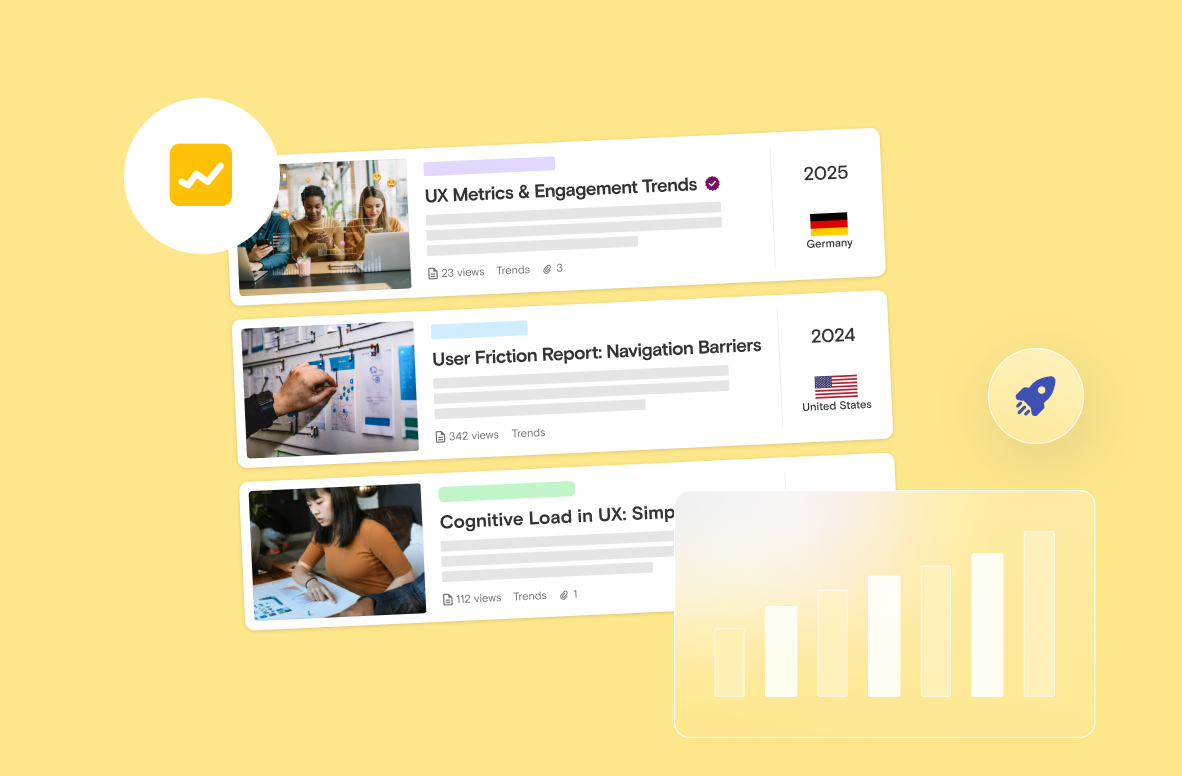TL;DR: Your 30-second overview
We know you’re busy. Here are the key takeaways:
- Why it matters: Without clear ROI knowledge management data, even the best platforms risk becoming underfunded or underused.
- What to measure: Key metrics like time saved, reduced duplicated work, higher reuse of insights, and faster decision-making.
- How to measure: Use a knowledge management ROI calculator or a custom model to track both tangible gains (cost savings, productivity) and intangible benefits (collaboration, innovation).
- Prove it: Share results with leadership regularly, tying them to business priorities.
- Get support: A purpose-built platform like Stravito offers built-in analytics, engagement metrics, and dashboards that make measuring ROI for knowledge management straightforward.
Your knowledge management system isn’t just a repository. It’s an investment. But if you can’t clearly show the return, it becomes an easy target for budget cuts.
A clear view of knowledge management ROI helps you secure funding, drive adoption, and demonstrate the strategic value of every insight your teams create.
And it all starts with understanding why it matters, not just to your team, but to every decision maker in the organization.
Why measuring knowledge management ROI matters
When leadership asks, “What’s the business value?”, they want clear numbers. They expect proof that your knowledge management system ROI delivers measurable impact.
Without a clear ROI knowledge management story, even the most user-friendly platform can lose funding or be replaced.
Unmeasured knowledge management initiatives often fade into the background. Projects without visible returns can become underfunded, underused, or eventually shut down.
This leads to:
- Lost insights
- Duplicated work
- Slower decision-making across the organization
Tracking and sharing the right metrics protects your investment. It also drives adoption, builds a stronger case for ongoing funding, and wins cross-functional support.
When you connect measurable outcomes to business strategies, knowledge management becomes a recognized driver of performance instead of a hidden tool.
For organizations ready to build that connection, a structured approach like the knowledge management framework makes it easier to measure from the start.
The next step is to define what knowledge management ROI actually means and how to calculate it.
The most impactful KM ROI metrics and KPIs to track
Measuring KM ROI means knowing which metrics truly reflect value. The right mix will capture both hard numbers and the intangible benefits that drive long-term success. These metrics should be relevant to your knowledge management initiative, align with business strategies, and be easy to track over time.
Core performance metrics
- Time-to-insight: How quickly can users find relevant information to support decision making?
- Reduction in duplicated work: Track how often projects or research are repeated due to poor knowledge sharing.
- Onboarding speed: Measure the time new team members take to reach full productivity.
- Content and insights reuse: Percentage of existing organizational knowledge applied to new projects, markets, or regions.
- User adoption and engagement metrics: Frequency of logins, searches, and views of high-value content.
- Compliance and audit success rates: Evidence that up-to-date information is being used to meet regulatory requirements.
Business outcome metrics
- Faster launches: Shorter timelines from idea to market release.
- Fewer errors: Reduction in costly mistakes thanks to better access to trusted insights.
- Increased win rates: Higher success in competitive bids or sales opportunities.
- Innovation pipeline: Number of innovative ideas developed from shared knowledge.
- Employee engagement: Positive changes in how employees interact with and share knowledge.
Tracking these KPIs gives you a holistic view of both direct and indirect results.
The goal is to link them to specific outcomes the business values most.
(For additional guidance on setting and tracking these metrics, explore Stravito’s resource on knowledge management KPIs.)
The next step is building an ROI model that uses these metrics to create a clear and credible picture for stakeholders.
How to build a knowledge management ROI model for your organization in 7 steps
An ROI model turns data into a clear story that stakeholders can act on.
It connects the metrics you track with business strategies, making it easier to demonstrate both direct returns and the broader cultural benefits of your knowledge management initiative.
Follow these steps to build a model that works for your organization:
Step 1. Define success
Align ROI goals with strategic priorities. If leadership is focused on innovation, highlight how a good knowledge management system helps generate and apply innovative ideas faster.Step 2. Establish baselines
Gather pre-implementation data. This could include the time employees spend searching for relevant information, onboarding timelines, or duplicated project costs. Baselines make determining impact and ROI for knowledge management straightforward.
Step 3. Select metrics
Use a balanced mix of quantitative measures (time saved, reduced costs, increased win rates) and qualitative ones (employee engagement, customer satisfaction). For inspiration, see knowledge management strategy examples that tie metrics directly to outcomes.
Step 4. Collect data
Combine platform analytics with surveys, interviews, and case studies. AI knowledge management tools can speed up analysis and ensure you have up-to-date information for each KPI.
Step 5. Calculate ROI regularly
Apply the formula and review results quarterly or annually. This prevents relying on outdated insights and ensures your ROI around knowledge management base reflects current business conditions.
Step 6. Share results with stakeholders
Package findings in a simple format with relevant metrics, clear ROI figures, and specific outcomes. Use visuals to make the impact easy to understand.
Step 7. Adjust and optimize
Use lessons learned to refine your knowledge management investments. For practical ideas, see our enterprise knowledge management tips.
When done well, your ROI model becomes a decision-making tool. It not only measures performance but also guides continuous improvement in how your organization captures, shares, and uses knowledge.
With the model in place, the next step is to avoid the common pitfalls that can weaken your results.
4 Common pitfalls in KM ROI measurement (and how to avoid them)
Even a well-planned knowledge management ROI calculation can fall short if you miss key details. Many organizations struggle with the same mistakes, which can lead to unclear ROI and weak business cases.
Overvaluing upload or file counts
Counting the number of documents added to a knowledge base is not the same as proving value. A good knowledge management system should focus on engagement metrics, reuse rates, and decision-making impact.
How to avoid it:
- Track usage alongside uploads.
- Look for patterns in how employees access and share knowledge.
- Focus on clear business benefits, not just activity.
Ignoring qualitative impact
Focusing only on hard numbers misses soft indicators like culture change, employee engagement, and continuous learning. These can influence customer satisfaction, innovation, and retention.
How to avoid it:
- Combine quantitative and qualitative metrics.
- Include feedback from team members and knowledge managers.
- Show how improved access to relevant information leads to specific outcomes.
Using the wrong baseline or time frame
If your baseline is inaccurate or your review period is too short, your ROI may not reflect the true ROI of knowledge management.
How to avoid it:
- Gather baseline data before implementation.
- Use realistic time frames that match your business cycles.
- Update measurements regularly to ensure up-to-date information.
Not iterating
KM initiatives are not “set it and forget it” projects. Without regular reviews, information silos can reappear, and employee productivity gains can fade.
How to avoid it:
- Schedule recurring ROI reviews.
- Use findings to guide continuous improvement in KM efforts.
- Keep stakeholders informed so decision makers see ongoing value.
By sidestepping these pitfalls, you protect your investment and strengthen your ability to measure the ROI of knowledge management accurately.
Next, we’ll look at how Stravito makes ROI measurement clear and actionable.
How Stravito makes KM ROI clear and actionable
Enterprises can only measure ROI when they have the right foundations in place.
Stravito provides the foundations for ROI by centralizing insights, encouraging adoption, and offering analytics that link knowledge use to business results.
Out-of-the-box analytics and dashboards
Stravito comes with built-in dashboards that track usage, engagement, time saved, and content gaps. You can see which insights are accessed most often, which markets or teams are reusing knowledge, and where gaps need to be filled.
This visibility lets you act quickly to improve coverage and ensure that employees always have relevant, up-to-date information.
Easy stakeholder reporting and success stories
With Stravito, it is simple to share clear, compelling reports with decision makers.
Engagement metrics, adoption rates, and examples of high-impact reuse can be exported in minutes. These reports give stakeholders both the hard numbers and the narrative that explains the platform’s value.
Real customer stories make the impact tangible:
- NPR created a single source of truth for research, giving cross-functional teams self-serve access to up-to-date audience insights. This reduced manual requests, freeing researchers to focus on higher-value work, while faster access to information improved decision-making speed.
- Roche consolidated insights globally to improve reuse and counter “insights inflation.” Existing research was applied across teams, reducing duplicated work and ensuring that each new study built on trusted knowledge.
- Heineken built a best-in-class insights ecosystem that made global insights easier to find and apply. Teams acted faster on trusted information, accelerating launches and driving innovation in multiple markets.
Built for ongoing optimization
Stravito is designed for real-time feedback, rapid scaling, and proven adoption. Engagement data helps administrators see what is working and where to improve.
As the platform scales to new teams, regions, or business units, insights remain easy to find and share, preventing information silos from reappearing.
Continuous improvement becomes part of the process, ensuring the platform delivers a clear ROI year after year.
Stravito doesn't just make it possible to measure ROI. It gives you the usage, adoption, and insight-sharing capabilities that make a strong ROI possible in the first place.
See the difference yourself by requesting a Stravito demo and start turning insights into measurable business value.
Final thoughts: Turning knowledge into measurable business value
We know valuable knowledge is created in your business every day. Your teams work hard to uncover research, customer insights, and market trends.
Yet too often, those insights are buried in folders, trapped in silos, or forgotten before they reach the people who need them.
When that happens, your business loses more than information. You lose time, momentum, and opportunities to grow or innovate.
And without proving the ROI of your knowledge management efforts, it is harder to protect budgets, drive adoption, and show the value your teams deliver.
With the right metrics, a strong ROI model, and Stravito as your partner, every insight can work harder for your business.
Your teams make faster decisions, eliminate duplicate work, and fill innovation pipelines with ideas built on trusted knowledge.
Do not let value slip through the cracks. Request a Stravito demo today and make your business’s knowledge count.
FAQs
What is knowledge management ROI?
It is the measure of the value your organization gains from its knowledge management efforts compared to the resources invested. ROI looks at both tangible returns, like time saved and reduced costs, and intangible benefits, such as improved collaboration and innovation.
Why is measuring ROI important for knowledge management?
Without measurement, it is difficult to prove the value of knowledge management to stakeholders. ROI data helps secure budgets, drive adoption, and ensure that insights are actively used to improve business outcomes.
How can a platform like Stravito help improve ROI?
Stravito centralizes insights, increases adoption across teams, and provides analytics that connect usage to real business results. This foundation makes it easier to measure and grow ROI over time.
What metrics should we track to measure ROI?
Metrics can include time to find insights, reuse of existing research, reduced duplicate projects, faster onboarding, and user engagement rates. A mix of quantitative and qualitative measures gives a full view of performance.
How often should we review ROI?
Quarterly or annual reviews are common, but regular monitoring ensures you can make timely adjustments. This helps maintain adoption, close content gaps, and keep ROI results aligned with business priorities.




